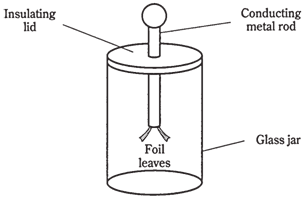Electrostatic deflection
Electric fields generate forces, just as do magnetic fields. We have probably noticed this when your hair feels like it is standing on end in very dry or cold weather. You have probably heard that people's hair does stand straight out before a lightning bolt hits nearby; this is not the myth. Maybe you performed experiments in science classes to observe the effect.
The most common device for representing electrostatic forces is the electro- scope. It comprise of 2 foil leaves, attached to the conducting rod, and placed in the sealed container so that air currents won't move the foil leaves. When the charged object is brought near, the contact at the top of the rod, the leaves stand apart from each other. This is because 2 leaves become charged with like electric poles-an excess or a deficiency of electrons-and like poles always repel each other.

Figure-- A simple electroscope.
The extent to which leaves stand apart depends upon the quantity of electric charge. It is difficult to measure this deflection and correlate it with the charge quantity; electroscopes do not make good meters. But variations on this theme can be used, so that electrostatic forces can operate against tension springs or magnets, and in this manner, electrostatic meters can be produced.
An electrostatic device has ability to measure alternating electric charges as well as steady charges. This gives electrostatic meters an advantage over the electromagnetic meters. If you connect alternating current to the coil of the galvanometer device in the Figure given, the compass needle might vibrate, but will not give deflection. This is because the current in 1 direction pulls the meter needle one way, and current in the other direction will deflect the needle the opposite direction. But if the alternating electric field is linked to the electrostatic meter, plates will repel whether the charge is positive or negative in nature. The deflection will be steady, thus, with alternating current as well as with direct current.
Most electroscopes are not sensitive to show much deflection with the ordinary 117-V utility voltage. Do not try connecting 117 V to electroscope; it might not deflect foil leaves, but it can present a danger to your body if you bring it out to points where you can come into physical contact with it.
An electrostatic meter has property which is sometimes an advantage in electrical or electronic work. The device does not draw any current, except the tiny amount at 1st, required to put a charge on the plates. Sometimes, an engineer or experimenter does not want the measuring device to draw current, as this affects the behavior of the circuit under test. Galvanometers, in contrast, always requires at least a little current in order to operate. We can observe this effect by charging the laboratory electroscope, with the glass rod which has been rubbed against a cloth. When the rod is pulled away from the electroscope, the foil leaves will remain standing apart. The charge sits there. If electroscope drew any current, the leaves would fall back together again, as the galvanometer compass needle returns to magnetic north the instant you take the wire from battery.